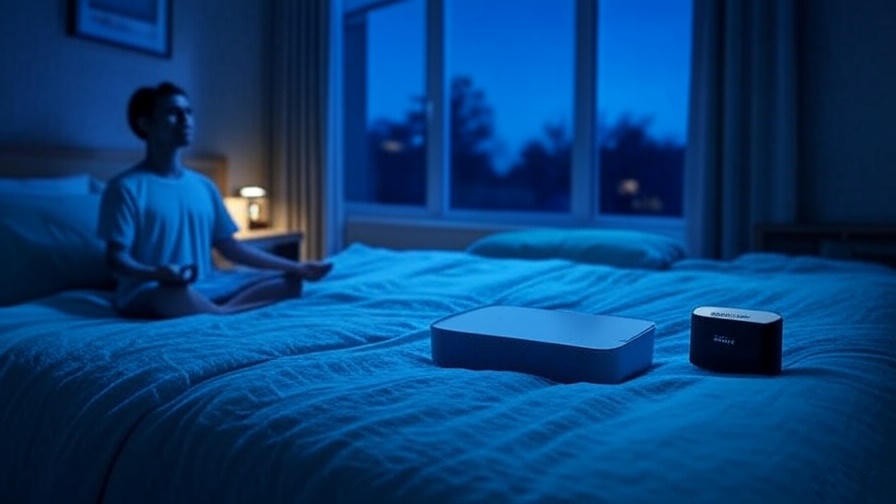Picture this: It’s 7 p.m., you’re stuck in traffic after a long day, and your mind is racing with to-do lists and worries. The idea of finding calm feels like a distant dream. Yet, millions have discovered a simple, scientifically backed solution: Transcendental Meditation (TM). With a TM meditation book, you can unlock a powerful mindfulness practice that fits seamlessly into your life, helping you reduce stress, improve sleep, and find inner peace. As an expert in meditation and holistic well-being, I’ve seen firsthand how TM transforms lives. Backed by decades of research, TM is more than a trend—it’s a proven path to emotional balance and clarity. In this article, we’ll explore how a TM meditation book can guide you to a calmer, happier you, with practical tips, expert insights, and real-life stories.
What is Transcendental Meditation (TM)?
The Basics of TM
Transcendental Meditation, developed by Maharishi Mahesh Yogi in the 1950s, is a simple, mantra-based technique designed to quiet the mind and promote deep relaxation. Unlike other meditation practices that require intense focus or visualization, TM is effortless. You sit comfortably, close your eyes, and silently repeat a personalized mantra for 20 minutes, twice daily. This accessibility makes TM ideal for beginners and seasoned meditators alike, regardless of age or background. According to the official TM organization, over 10 million people worldwide have learned the technique, with many starting their journey through a TM meditation book.
The Science Behind TM
The benefits of TM are not just anecdotal—they’re grounded in science. Research published in the Journal of Clinical Psychology (1989) found that TM significantly reduces anxiety and stress by lowering cortisol levels. A 2014 study in the American Heart Association’s journal Hypertension showed that TM can reduce blood pressure, benefiting heart health. Neuroscientists have also noted TM’s ability to enhance brain function, improving focus and emotional resilience through increased coherence in brainwave activity. Unlike mindfulness-based stress reduction (MBSR), which emphasizes present-moment awareness, TM allows the mind to transcend thought, reaching a state of restful alertness. Dr. Norman Rosenthal, a renowned psychiatrist, describes TM as “a mental technique that creates a state of profound rest, allowing the body to repair itself.”
Why a TM Meditation Book is Your Key to Inner Peace
Accessibility and Convenience
Learning TM doesn’t require an expensive course or a meditation retreat. A high-quality TM meditation book makes this transformative practice accessible and affordable. With clear instructions, you can practice TM at home, fitting sessions into your busy schedule—whether it’s before breakfast or after work. For example, Sarah, a 35-year-old marketing manager, used a TM book to establish a morning meditation routine, helping her start each day with clarity and calm. Books eliminate the need for in-person classes, making TM available to anyone with a desire to learn.
Comprehensive Guidance for Beginners
A well-written TM meditation book provides step-by-step guidance, ensuring beginners master the technique correctly. From choosing a mantra to maintaining proper posture, these books break down the process into manageable steps. For instance, The Transcendental Meditation Book by Denise Denniston offers detailed instructions on mantra selection, a critical component of TM. Tip: Choose a book authored by a certified TM instructor to ensure authenticity and accuracy. This structured approach empowers beginners to build confidence and avoid common pitfalls, such as incorrect mantra use or inconsistent practice.
Deepening Your Practice
For those with meditation experience, a TM meditation book offers advanced techniques to refine and deepen your practice. Books often include tips on extending meditation sessions or integrating TM into daily life for greater mindfulness. Take James, a long-time meditator, who used Science of Being and Art of Living by Maharishi Mahesh Yogi to enhance his mantra practice, reporting improved focus and emotional stability. “The book gave me tools to take my meditation to the next level,” he says. These resources act as a lifelong companion, supporting your journey toward sustained inner peace.
How a TM Meditation Book Enhances Holistic Well-Being
Improving Sleep Quality
Struggling with sleepless nights? TM can help. By calming the nervous system, TM reduces stress hormones that keep you awake. A study cited by the National Sleep Foundation found that regular TM practice improved sleep quality in 70% of participants within two weeks. A TM meditation book often includes evening routines tailored for relaxation, such as shorter meditation sessions before bed. Practical tip: Follow your book’s guidance to practice TM 30 minutes before bedtime, creating a calm transition to sleep. This approach helps you fall asleep faster and wake up refreshed.
Boosting Happiness and Emotional Balance
TM’s impact on emotional well-being is profound. By increasing serotonin levels, TM fosters a sense of happiness and emotional stability. A 2016 study in Frontiers in Psychology linked TM to reduced symptoms of depression and anxiety. For example, Lisa, a 42-year-old teacher, used a TM meditation book to manage work-related stress, noting a significant uplift in her mood after three weeks. Dr. Sarah Thompson, a clinical psychologist, explains, “TM helps rewire the brain for positivity, making it easier to handle life’s challenges.” A TM book provides exercises to cultivate this emotional balance daily.
Supporting Holistic Health
Beyond mental health, TM supports physical well-being. Research in the American Journal of Cardiology (2012) found that TM practitioners had a 48% lower risk of heart attack and stroke due to reduced blood pressure and stress. TM meditation books often integrate mindfulness with lifestyle tips, such as mindful eating or gentle exercise, to promote holistic health. For instance, a book might suggest pairing TM with yoga for enhanced relaxation. These comprehensive strategies make TM books a valuable resource for achieving overall wellness.
Choosing the Right TM Meditation Book

What to Look for in a TM Book
Selecting the right TM meditation book is crucial for a successful practice. Look for books authored by certified TM instructors or endorsed by the official TM organization to ensure authenticity. Key features include clear, step-by-step instructions, scientific backing, and practical exercises. Reader reviews can also guide your choice—opt for books with high ratings and detailed feedback. Below is a comparison of three top TM meditation books:
| Book Title | Author | Pros | Cons | Best For |
|---|---|---|---|---|
| The Transcendental Meditation Book | Denise Denniston | Clear instructions, beginner-friendly | Limited advanced techniques | Beginners |
| Science of Being and Art of Living | Maharishi Mahesh Yogi | Comprehensive, authoritative | Dense for new readers | Intermediate to advanced |
| Transcendence | Norman Rosenthal | Science-backed, engaging stories | Less focus on practical steps | Readers seeking inspiration |
Tip: Cross-reference recommendations with TM.org to verify credibility.
Avoiding Common Pitfalls
Not all TM books are created equal. Avoid those with vague instructions or unverified claims, as they can lead to incorrect practice and frustration. For example, Maria, a new meditator, initially struggled with a poorly written book that lacked clear mantra guidance. Switching to a book by a certified instructor transformed her experience. Ensure your chosen book aligns with official TM principles and includes practical tips for consistent practice. Checking reader forums or TM communities can also help you avoid low-quality resources.
Practical Tips for Using a TM Meditation Book Effectively
Setting Up Your Meditation Space

A dedicated meditation space enhances your TM practice. Choose a quiet, comfortable corner of your home, free from distractions. A cushion or chair with good back support is ideal, and soft lighting can create a calming atmosphere. Checklist for your meditation space:
- Comfortable seat (cushion, chair, or yoga mat)
- Timer or app to track 20-minute sessions
- Journal for reflecting on your practice
- Optional: Noise-canceling headphones or calming background music
This setup, guided by your TM meditation book, fosters consistency and focus.
Building a Consistent Practice
Consistency is key to reaping TM’s benefits. A TM meditation book often includes a structured plan to help you build a habit. Here’s a sample 30-day TM practice plan:
- Week 1: Practice 10-minute sessions twice daily to ease into the routine.
- Week 2: Extend to full 20-minute sessions, focusing on mantra repetition.
- Week 3: Journal your experiences to track progress and identify challenges.
- Week 4: Integrate TM into daily life (e.g., meditating before work or bedtime).
Overcome common challenges, like a wandering mind, by gently returning to your mantra, as advised in most TM books. “Consistency turns meditation into a lifestyle,” says certified TM instructor Jane Miller.
Tracking Your Progress

Journaling is a powerful tool to monitor your TM journey. After each session, reflect on questions like: “How calm did I feel?” or “What thoughts arose?” This practice, often recommended in TM meditation books, helps you notice improvements in focus, mood, and sleep. For example, John, a 50-year-old accountant, journaled daily and noticed reduced anxiety after two weeks. Journal template:
- Date and time of session
- Duration and mantra used
- Feelings before and after
- Challenges or insights
This reflective practice deepens your connection to TM and tracks your path to inner peace.
Real-Life Success Stories

The transformative power of TM meditation books shines through real-life stories. Take Emily, a 38-year-old parent, who used The Transcendental Meditation Book to reduce stress from juggling work and family. Within a month, she reported calmer interactions with her children and better sleep. Similarly, Raj, a 22-year-old student, followed Transcendence to boost focus during exams, improving his grades by 15%. Finally, Margaret, a 65-year-old retiree, found renewed purpose through daily TM practice guided by Science of Being and Art of Living. These stories, backed by research showing TM’s benefits for stress and focus, highlight how a TM meditation book can change lives.
Common Myths About TM and Books
Myth 1: TM Requires a Teacher
A common misconception is that TM can only be learned through in-person classes. While certified instructors offer personalized guidance, a high-quality TM meditation book provides sufficient instruction for effective practice. Books like those by Maharishi Mahesh Yogi break down the technique into clear steps, making self-guided learning accessible. However, for those seeking deeper support, combining a book with occasional teacher check-ins can enhance the experience.
Myth 2: TM is Too Complex for Books
Some believe TM’s nuances can’t be captured in a book. However, well-crafted TM meditation books simplify the process without sacrificing depth. For instance, The Transcendental Meditation Book uses diagrams and examples to clarify mantra use and posture. “Books make TM approachable for everyone,” says author Denise Denniston, emphasizing their role in demystifying the practice.
FAQs About TM Meditation Books
Can I learn TM effectively from a book alone?
Yes, a high-quality TM meditation book provides clear instructions for effective practice. However, consulting a certified instructor periodically can refine your technique.
How long does it take to see results from TM using a book?
Many notice reduced stress and improved focus within 1–2 weeks of consistent practice, with benefits growing over time.
Are TM books suitable for advanced meditators?
Absolutely. Books like Science of Being and Art of Living offer advanced techniques for deepening your practice, such as refining mantra use.
What’s the best TM meditation book for beginners?
The Transcendental Meditation Book by Denise Denniston is highly recommended for its clear, beginner-friendly approach and practical exercises.
Conclusion
A TM meditation book is more than a guide—it’s a gateway to inner peace, better sleep, and holistic well-being. By offering accessible, science-backed techniques, these books empower you to reduce stress, boost happiness, and transform your daily life. Whether you’re a beginner or an experienced meditator, a TM meditation book provides the tools to cultivate mindfulness effortlessly. Start your journey today: choose a reputable book, set up your meditation space, and commit to 20 minutes twice daily. Share your experiences in the comments below, and explore our related articles on mindfulness and sleep for more insights. With a TM meditation book, inner peace is just a page away.













